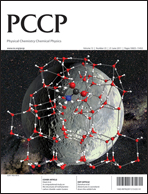Effects of deposited Pt particles on the reducibility of CeO2(111)†
Abstract
The interaction of Pt particles with the regular CeO2(111) surface has been studied using Pt8 clusters as representative examples. The atomic and electronic structure of the resulting model systems have been obtained through periodic spin-polarized density functional calculations using the PW91 exchange-correlation potential corrected with the inclusion of a Hubbard U parameter. The focus is on the effect of the metal–support interaction on the surface reducibility of ceria. Several initial geometries and orientations of Pt8 with respect to the ceria substrate have been explored. It has been found that deposition of Pt8 over the ceria surface results in spontaneous


 Please wait while we load your content...
Please wait while we load your content...